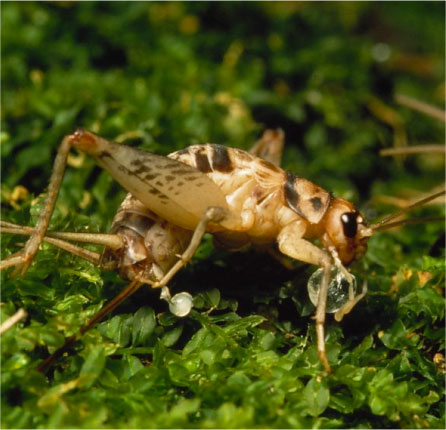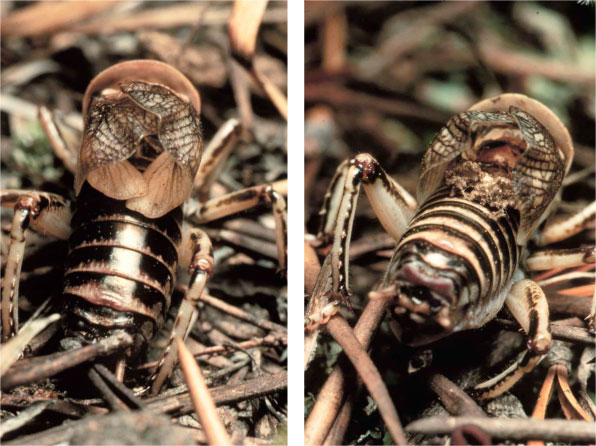
Susan Gershman
Dr. Susan Gershman
Contact Me:
Susan N. Gershman
Assistant Professor
The Ohio State University, The Ohio State University at Marion
Department of Evolution, Ecology and Organismal Biology
390 Morrill Hall
1465 Mount Vernon Ave
Marion, OH 43302
Phone: (740) 725-6129
Email Me
CV (PDF) - updated 2012
Research Interests :
Overview
I am an evolutionary biologist who studies the evolution of animal behavior. I am most interested in interactions between males and females. In many instances, behavioral and morphological traits that give individuals an advantage when they compete with members of the same sex can have negative effects on the opposite sex. One of the especially exciting byproducts of this is the coevolutionary arms race between males and females over conflicting optimal fitness strategies.
I have primarily used crickets as a study system, but I also work with Drosophila flies, beetles and salamanders. Although these animals are small and easily manipulated in the laboratory, the behaviors that they demonstrate are representative of similar interactions in other less tractable taxa. Some of the research questions that I address include: What behavioral and morphological adaptations do males use to outcompete other males for reproductive success? How do adaptations that help males outcompete other males affect females? When male traits that are attractive to females are complex, how can selection act on these traits and on female preference for male traits? To address these questions, my research draws on techniques from behavioral ecology, life history evolution, quantitative genetics, immunology, and analytical chemistry.
Past and Current Research
(1) Sexual conflict over courtship feeding gifts: spermatophylax composition as a multivariate trait
 |
Males of many taxa are required to contribute courtship gifts to females for successful copulation and sperm transfer. In orthopterans, males often produce large nutritive courtship gifts that they transfer to females, in addition to small packets that contain sperm. In G. sigillatus, these gifts have not been found to help offspring success. Instead, the spermatophylax (edible courtship gift) prevents the female from removing the male sperm packet before most of his sperm has been transferred to her sperm storage organ. Further, due to accessory gland products in the spermatophylax, consumption of the spermatophylax causes females to delay mating again (Gordon et al. in press). Therefore the spermatophylax both serves as ejaculate protection, and reduces sperm competition for the male. Females, however, may gain genetic benefits for their offspring from mating with more than one male, thus consuming the spermatophylax may not be in her best interest.
In my postdoctoral work with the Sakaluk lab, I examined the amino acid composition of the spermatophylax using gas chromatography, to study relationships between different amino acids and female willingness to accept and consume a spermatophylax. We found that the amino acid composition of the spermatophylax is highly heritable. Further, female resistance to consuming spermatophylaxes is also highly heritable. This information suggests that there is the potential for natural and sexual selection to act on these traits. Using selection analysis to determine which multivariate combinations of amino acids are most attractive to females, we found that the fitness surface is saddle-shaped, indicating that there is more than one combination of amino acids that results in an attractive spermatophylax. This selection analysis also provides an index of "spermatophylax attractiveness" to females. The heritability of spermatophylax attractiveness is highly significant, and the genetic correlation between spermatophylax attractiveness and female resistance to consuming spermatophylaxes is significant, indicating potential sexual conflict between males and females over the amino acid composition of the spermatophylax (Gershman et al. in prep).
(2) Sexual selection and plasticity in Drosophila flies: male olfactory display as a multivariate trait
In my current research with Howard Rundle, I am continuing to use quantitative genetic techniques, as well as gas chromatography to examine sexual selection in Drosophila serrata flies. In Drosophila flies, males produce olfactory signals that attract females. Males create these complex displays by varying the production of different cuticular hydrocarbons (CHCs). Previous research has found that there is a specific multivariate combination of CHCs that is most attractive to females. As a signal of male quality that is costly for males to produce, it is predicted that males will produce CHCs in an efficient way: males should produce the most attractive CHCs when there is the highest probability of attracting a female. I have been studying male plasticity in CHC production, and female plasticity in preference for male CHCs (Gershman et al. in prep). I am currently investigating how male CHCs change with male age, mating experience and over 24-hour circadian cycles as well as the effect of these conditions on male CHC attractiveness to females. Thus far it appears that male CHCs fluctuate over a 24-hour cycle and males display the most attractive profiles when they are most likely to attract a female.
(3) The immunological costs of mating
 |
Male sagebrush crickets before and after mating. Males allow females to chew their hindwings as a courtship gift, impairing male immunity. |
One potential cost of mating for both males and females can be a reduction in the ability to fight future immunological challenges: trade-offs between immunity and reproduction can influence the optimal number of times for each sex to mate. In my dissertation research I found that Gryllus vocalis vocal field cricket females suffered an immunological cost to mating, however males (who contribute only sperm packets during mating) did not (Gershman 2008 Behav Ecol 19:810-815). In my postdoctoral research with the decorated cricket Gryllodes sigillatus and the sagebrush cricket Cyphoderris strepitans, two species in which males contribute large courtship feedings to females during mating, males with increased reproductive effort suffered a decreased ability to combat future immunological challenges (Gershman et al. 2010 Heredity 105:282-289; Leman et al. 2009 J Evol Biol 22:163-171). As predicted by life history theory, in both G. vocalis and G. sigillatus, males have a reduced ability to mount an immune response as compared to females (Gershman et al. 2010 J Evol Biol 23:829-839). In additional work done in collaboration with Sandra Steiger and Anne-Katrin Eggert, we found that both male and female burying beetles upregulate immunity during their period of biparental care (Steiger et al. in press Funct Ecol).
Thus mating can have a negative effect on immunity. Further, there is a trade-off between reproductive effort and immunity that can be seen both between the sexes and among species with divergent patterns of reproductive investment. When males contribute little reproductive effort per mating, females suffer greater immunological costs than males, and these costs may limit the optimal mating rate for females. However, when males make a large investment in reproduction, they may similarly suffer an immunological cost to mating. Immunological costs may limit the optimal number of matings for these males and potentially upend the assumption that males gain more from more mating many times than females do.
(4) Female choice for novel partners
In many taxa, including crickets, females may choose one male instead of another based on traits that indicate male quality. However, females can also gain benefits by choosing to mate with different males, independent of male quality: females that mate with different males have more opportunities to acquire combinations of genes that increase offspring success. In contrast to male preference for novel females, female preference for novel males has been studied in relatively few species. Further, female choice to bias sperm in favor of novel males (postcopulatory choice) had not been previously studied. As one component of my dissertation, I found that females preferred novel males to previous partners, and were faster to remove the sperm packet and terminate sperm transfer from previous mates (Gershman 2008 Evolution 63:67-72). In my postdoctoral work I found a similar pattern of female postcopulatory choice in Gryllodes sigillatus, despite the presence of an ejaculate-protecting courtship gift from the male (Gershman and Sakaluk 2010 Ethology 116:1113-1117). I also found that in G. vocalis, female sperm removal behavior caused previous mates to lose paternity to males that were novel to the female (Gershman 2008 Evolution 63:67-72). Thus although female preference for novel partners can improve female fitness by adding diversity to her offspring, it can have a negative effect on male fitness, causing a conflict between males and females.
Surprisingly, in G. sigillatus, males did not have a preference for novel female partners (Gershman and Sakaluk 2009 Ethology 115: 774-780), suggesting that males either lack the ability to identify past female partners or that female discrimination against novel males renders male preference unnecessary.
(5) Sexual conflict over the optimal number of times to mate
For my dissertation research, I studied the vocal field cricket Gryllus vocalis, a species of field cricket in which females mate many time, to determine whether mating large numbers of times was beneficial to female lifetime reproductive success, or beneficial to only males. I found that females mated more times than was beneficial to their reproductive success, however even mating at such high rates did not have survival costs for females (Gershman 2007 Ethology 113:1099-1106). Further, these reproductive benefits were mediated by diet quality, such that females reared on a low quality diet did not gain reproductive benefits from mating large numbers of times (Gershman 2008 Evol Ecol Res 10:269-280).
Publications:
Gershman, S. N., M. Delcourt and H. D. Rundle (in prep) Female preferences for male cuticular hydrocarbons in Drosophila serrata are not affected by female age or mating status
Steiger, S, S. N. Gershman, A. M. Pettinger, A.-K. Eggert and S. K. Sakaluk. (provisionally accepted) Dominance status and sex influence nutritional state and immunity in burying beetles Nicrophorus orbicollis. Behavioral Ecology
Gordon, D. G., S. N. Gershman and S. K. Sakaluk. (in press) Glycine in nuptial food gifts of decorated crickets decreases female sexual receptivity when ingested, but not injected. Animal Behaviour.
Steiger, S., S. N. Gershman, A. M. Pettinger, A.-K. Eggert and S. K. Sakaluk. (in press) Sex differences in immunity and rapid upregulation of immune defense during parental care in the burying beetle, Nicrophorus orbicollis. Functional Ecology.
Gershman, S. N., C. Mitchell, S. K. Sakaluk and J. Hunt. (in press) Biting off more than you can chew: sexual selection on the free amino acid composition of the male spermatophylax in decorated crickets. Proceedings of the Royal Society B.
Gershman, S. N., J. Hunt and S. K. Sakaluk. (submitted). Food fight: Sexual conflict over free amino acids in the nuptial gifts of male decorated crickets. Evolution.
Gershman, S. N. and S. K. Sakaluk. 2010. Mate quality and novelty influence post-copulatory female choice in decorated crickets, Gryllodes sigillatus. Ethology 116:1113-1117.
Kerr, A. M., S. N. Gershman, and S. K. Sakaluk. 2010. Experimentally-induced spermatophore production and immune responses reveal a trade-off in crickets. Behavioral Ecology 21:647-654.
Gershman, S. N., C. A. Barnett, A. M. Pettinger, C. B. Weddle, J. Hunt, and S. K. Sakaluk. 2010. Give 'til it hurts: trade-offs between immunity and male reproductive effort in the decorated cricket, Gryllodes sigillatus. Journal of Evolutionary Biology 23:829-839.
Gershman, S. N., C. A. Barnett, A. M. Pettinger, C. B. Weddle, J. Hunt, and S. K. Sakaluk. 2010. Inbred decorated crickets exhibit higher immunity than outbred individuals. Heredity 105:282-289.
Gershman, S. N. 2009. Large numbers of matings do not give female Gryllus vocalis vocal field crickets a genetic benefit. Journal of Insect Behavior 23:59-68.
Gershman, S. N. and S. K. Sakaluk. 2009. No Coolidge effect in decorated crickets. Ethology 115: 774-780.
Leman, J. C., C. B. Weddle, S. N. Gershman, A. M. Kerr, G. D. Ower, J. M. St. John, L. A. Vogel, and S. K. Sakaluk. 2009. Lovesick: immunological costs of mating to male sagebrush crickets. Journal of Evolutionary Biology 22:163-171.
Gershman, S. N. 2008. Post-copulatory female choice increases the fertilization success of novel males in the field cricket, Gryllus vocalis. Evolution 63:67-72.
Gershman, S. N. 2008. Sex-specific differences in immunological costs of multiple mating in Gryllus vocalis field crickets. Behavioral Ecology 19:810-815.
Gershman, S. N. 2008. Diet quality mediates the effect of multiple mating on female Gryllus vocalis vocal field cricket lifetime reproductive success. Evolutionary Ecology Research 10:269-280.
Gershman, S. N. 2007. Female Gryllus vocalis field crickets gain diminishing returns from increasing numbers of matings. Ethology 113:1099-1106.
Gershman, S. N. and P. A. Verrell. 2002. To persuade or be persuaded: which sex controls mating in a plethodontid salamander? Behaviour 139:447-462.